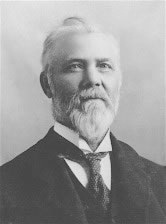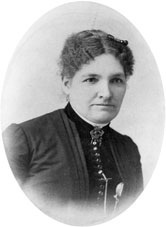Bowles Family
Joseph W. Bowles seemed to succeed at everything he tried. As a young man of twenty-two, he came to Colorado and to Gregory Gulch (now Blackhawk) with the 1859 gold rush. Not long afterward he located a rich claim in the Nevada mining district which he mined for three years. There he was elected sheriff under the laws of the miners' organization and served two terms. In 1862 he came to the Littleton area and settled west of the South Platte River and south of present Bowles Avenue (named for him.) His first land purchase of 160 acres in that valley was in 1867. He hurried to build a log house before his marriage in December that year to Cynthia Rae (Blackburn) Miller, the daughter of Gideon Blackburn Miller of Pettis County, Missouri. Joseph and Cynthia were to live in this home for seventeen years until the magnificent main house now known as Willowcroft was built in 1884.


Joseph and Cynthia Bowles, date unknown.
Meanwhile, Bowles bought more land to the west and northwest of the original "homestead." until he eventually accumulated about 2,000 acres near Littleton. Convinced of the value of irrigation, he, with George W. Harriman, surveyed a ditch from Bear Creek near Morrison to lands south of Bear Creek and west of the river. They also constructed Harriman Lake for a storage reservoir, and Bowles continued to build lakes on his own property.
Quickly successful at farming, Bowles also developed an enormous cattle-raising operation. He used pasture in the San Luis Valley until he purchased about 4,000 acres on the Republican River near Wray in eastern Colorado in 1876. This Bar Eleven Ranch became "one of the most famous ranches on the western plains" and was also known for its hospitality. It was the time of the open range. Bowles' son, Edward, later said that his father ran 8,000 to 9,000 head of Texas longhorns that wandered from the Arkansas River on the south to the Platte on the north. They bought their steers from trail herds that were driven over the Chisholm Trail from Texas to Montana.
The original Littleton farm continued to be the family's residence, and by 1889, when three railroads had reached Littleton, Bowles' land holdings proved to be strategically located for the area's growth as a farming and commercial center. He and his neighbors were, however, strongly opposed to paying Littleton city taxes, and in late 1889 they voted to incorporate as the separate town of Wynetka. Wynetka existed for shortly more than two years. Although it was discontinued in April 1892, Bowles continued to use the Wynetka letterhead as late as 1905.
Joseph Bowles was also influential and prominent in public and other business affairs. He was elected county commissioner in 1869 and again in 1874 and was sent to the state legislature by Arapahoe County voters in 1880. For several years he served as director of Denver's City National Bank and was the executive commissioner of the first state grange. Locally he joined with Richard S. Little, John Lilley, Peter Magnes, John McBroom, and others in forming the Rough and Ready Mill in 1867. Bowles was a charter member of Littleton's Weston Masonic Lodge and was one of the first directors of the Littleton Cemetery Association. He was an early member of Richard Little's St. Paul Episcopal Church but later helped form its split-away congregation, The First Reformed Episcopal Church in America. Cynthia was a Roman Catholic and was active in the Women's Art Club.
Joseph and Cynthia Bowles had five children: Charles, born 1869; Edward, born 1871; Josephine, born 1876; Harry, born 1879, and Walter, born 1881. Harry died in infancy and Josie died at age eleven. Their father, although having been a lifelong Protestant, converted to Catholicism to grant Josie's dying wish. Cynthia died in 1901, and that same year Joseph donated the land and the biggest share of the money to build St. Mary's Catholic Church at Nevada and High (now Powers) streets.
Joseph Bowles lived until 1906 and died on his original farm west of Littleton. By that time his son Edward had taken over management of the ranches. The local real estate holdings consisted of three sections: one was west of the Platte River and south of Bowles Avenue; one was west of Platte Canyon Road and south of Bowles, and the third was north of Bowles and included all of Bowles Lake and part of Marston Lake. The family later sold some of the latter farm to the Beers sisters where they established their well-known dairy.
Joseph and Cynthia Bowles and all of their children, except Charlie, are buried in the Littleton Cemetery. The June 6, 1891 edition of the Littleton Independent carries an article reflecting back on the events of "Decoration Day:"
"Mr. J. W. Bowles has erected a most beautiful monument over the grave of his daughter in the Littleton Cemetery. The monument consists of a heavy granite pedestal, with a massive marble shaft surmounted by a life size statue of Miss Bowles. We are informed that the statue was made in Italy, and it is a pronounced to be very lifelike. As a work of art, it is surpassingly beautiful, and is a fitting tribute of parental affection to the tender memory of a beloved child. It was also a pleasing surprise to Mrs. Bowles who had not been apprised of the monument having been put in place until her arrival at the cemetery on Decoration Day."
Bibliography
O. L. Baskin and Company. History Of the City Of Denver, Arapahoe County, and Colorado. Chicago: Baskin and Company, 1880.
Keller, Carolyn. "Joseph W. Bowles. 1835-1906." Research paper prepared for Littleton Historical Museum. Denver, Colo.: University of Colorado at Denver, 1989.
Littleton Independent. Littleton, Colo.; The Littleton Independent Publishers, 1888- .
Littleton Museum. Biographical File: "Bowles."
Littleton Museum. Photograph Collection: "Bio: A-F."
McQuarie, Robert J. and C. W. Buchholtz. Littleton, Colorado. Settlement To Centennial. Littleton, Colo.: Littleton Historical Museum and Friends of the Littleton Library and Museum, 1990.
Freemasons, Littleton (Colo.) Weston Lodge Number Twenty-two, A. F. & A. M., 1872-1973. Littleton, Colo.: A. F. & A. M., 1973.
Sanford, Albert B. "One Of Colorado's Successful Farmers and Cattlemen, A Pioneer Of Gregory Gulch, 1859." Colorado Magazine. Denver, Colo,: Historical Society of Colorado, January, 1925.
Photographs courtesy of the Littleton Museum unless otherwise noted. To order copies, contact the museum at 303-795-3950.
Compiled by Doris Farmer Hulse
Updated March 2021 by Phyllis Larison